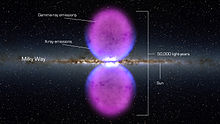Fermi bubble
The Fermi bubbles (after the gamma radiation satellite Fermi Gamma-ray Space Telescope , with whose Large Area Telescope they were discovered) are spherical structures that can be observed in the spectral range of gamma radiation . Their diameter is about 55 ° north and south of the plane of the Milky Way . The two bubbles “stand” perpendicular to this plane, are centered on the gravitational center of our galaxy and show a spectral index of −2, which deviates from diffuse gamma radiation .
description
The Fermi bubbles were first described in 2010 as a nebulous structure above and below the plane of the Milky Way in the range between 100 M eV and 100 GeV. The structures were later in the spectral ranges of microwaves in the data of the WMAP satellite and the X-rays from the ROSAT - survey discovered. Similar bubble-like structures have been observed around the galaxies Centaurus A , M82 and possibly M31 .
Hypotheses about the formation of Fermi bubbles see the cause of the gamma radiation
- in the acceleration of cosmic rays during an AGN outbreak in the central massive black hole Sagittarius A *
- by a starburst in the center of the Milky Way or
- in an accumulation of cosmic rays by supernovae in star formation regions .
In the latter case, a magnetic structure outside the Milky Way plane would be required to capture cosmic rays. It is not yet known whether the gamma radiation is caused by an interaction of hadrons with the interstellar gas or by inverse Compton scattering of high-energy electrons with the interstellar radiation field.
literature
- Su Meng et al .: Giant Gamma-ray Bubbles from Fermi-LAT: Active Galactic Nucleus Activity or Bipolar Galactic Wind? 2010, arxiv : 1005.5480v3 (English).
- Dmitry Malyshev: Fermi Bubbles: an Elephant in the Gamma-ray Sky . In: Astrophysics. Solar and Stellar Astrophysics . 2017, arxiv : 1704.02629v1 (English).
- Rongmon Bordoloi et al .: Nuclear Outflow of the Milky Way: Studying the Kinematics and Spatial Extent of the Northern Fermi Bubble . In: Astrophysics. Solar and Stellar Astrophysics . 2016, arxiv : 1612.01578v1 (English).
- Kartick C. Sarkar, Biman B. Nath, Prateek Sharma: Clues to the origin of Fermi Bubbles from OVIII / OVII line ratio . In: Astrophysics. Solar and Stellar Astrophysics . 2016, doi : 10.1093 / mnras / stx314 , arxiv : 1610.00719v2 (English).
- Matthew J. Miller, Joel N. Bregman: The Interaction of the Fermi Bubbles with the Milky Way's Hot Gas Halo . In: Astrophysics. Solar and Stellar Astrophysics . 2016, doi : 10.3847 / 0004-637X / 829/1/9 , arxiv : 1607.04906v1 (English).
